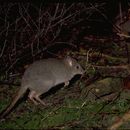ar
الأسماء في صفحات التنقل


Where food resources are adequate, density of cover is the limiting factor on population size. Since the advent of European man, this limiting factor has assumed prime importance. Where it has not been excluded from its normal habitat by agricultural clearing or the impact of grazing animals, B. penicillata is now restricted by Red Foxes, although attempts have now been made to control these foxes. The last remaining populations in south-west Western Australia are in the Perup and Dryandra forests and the Tuttanning Reserve where the habitat is under active management directed to their survival (Christensen 1983).
Perception Channels: tactile ; chemical
Members of this speices are no longer present in Victoria, and are now found only in a few localities in south-west Western Australia. Recent Red Fox control at several sites in this region resulted in substantial population increases of B. penicillata (up to 400%) as well as increases in distributional range. It has been introduced to several islands in South Australia, but only two of these islands are capable of maintaining viable populations in the long-term (Seebeck 1995).
IUCN Red List of Threatened Species: critically endangered
N/A
N/A
Bettongia penicillata does not drink water or eat any green plant material. It is primarily fungivorous, its food consisting largely of the fruiting bodies of underground fungi, supplemented by bulbs, tubers, seeds, insects and resin, probably from Hakea shrubs. The proportion of fungal material in the diet is greatest in summer and autumn. Being deficient and imbalanced as a source of amino acids, fungus is not a good food for mammals but B. penicillata does not utilize it directly. Bacteria in the large sacculated fore-stomach digest the fungus, and these bacteria and their by-products, which constitute a more balanced diet, are themselves digested in the posterior part of the stomach and small intestine (Christensen 1983).
Widespread at the time of European colonization, Bettongia penicillata is now confined to south-west Western Australia (Christensen 1983).
Biogeographic Regions: australian (Native )
Bettongia penicillata appears to have been primarily an animal of open forests and woodlands. A common characteristic in all habitats occupied by the surviving populations in south-west Western Australia is a clumped, low understory of tussock grasses or clumped, low, woody shrubs (Christensen 1983).
Average lifespan
Status: captivity: 18.8 years.
The head and body length of B. penicillata ranges from 300-380 mm. Its tail length ranges from 290-360 mm. Its body is yellowish-grey above and paler below (Christensen 1983). The feet of B. penicillata are pale brown with bristly hairs not concealing the claws. Its long tail has a prominent black crest along the terminal third or two-thirds of the upper surface. The undersurface of its tail is pale brown (Lydekker 1894). Males and females are similar in appearence and no geographic variation has been reported (Christensen 1983).
Range mass: 1.1 to 1.6 kg.
Other Physical Features: endothermic ; bilateral symmetry
Average basal metabolic rate: 3.132 W.
In B. penicillata, bredding is continuous (Christensen 1983). The gestation period is 21 days. A single altricial young is born, which has a short pouch life of about 98 days (Seebeck 1995). The young subsequently accompanies its mother at heel, sharing her nest until the next infant vacates the pouch and displaces it. While sharing the nest, the young continues suckling. A female gives birth to its first young at the age of 170-180 days and approximately every 100 days thereafter for the rest of its life of 4-6 years. Embryonic diapause is exhibited. (Christensen 1983).
Key Reproductive Features: gonochoric/gonochoristic/dioecious (sexes separate); sexual
Average birth mass: 0.29 g.
Average gestation period: 18 days.
Average number of offspring: 1.
Average age at sexual or reproductive maturity (female)
Sex: female: 180 days.